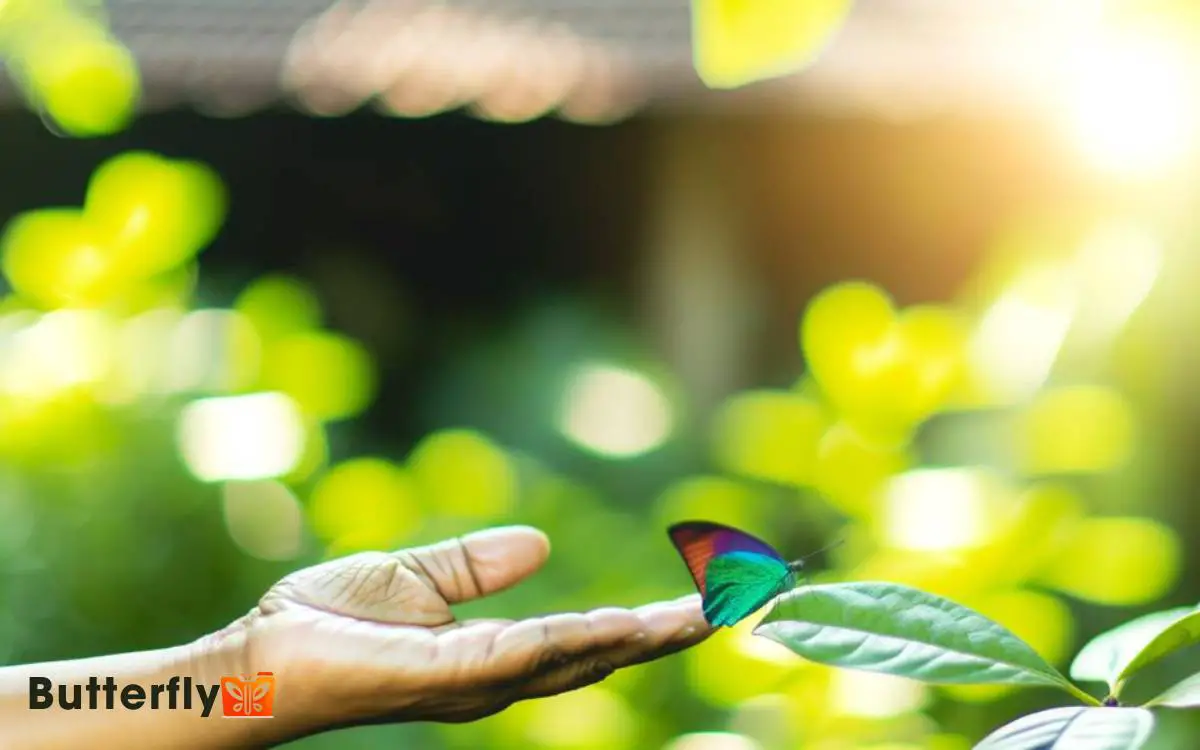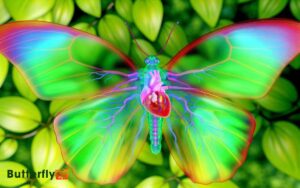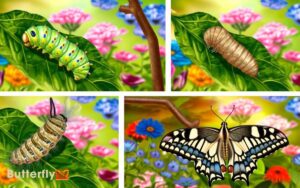Are Butterflies Poisonous to Touch? Understanding Safety!
Touching butterflies generally isn’t dangerous, but the tiny scales on their wings can potentially cause minor irritation. These scales may contain toxins like alkaloids and cardenolides, which function as defense mechanisms.
People with allergies or asthma should be particularly cautious. Understanding more about their defense mechanisms and safe handling practices could enhance your experiences with these beautiful insects.

Key Takeaways
Butterfly Anatomy Basics
To understand if butterflies are poisonous to touch, you first need to grasp the basics of their anatomy. Butterflies have three main body parts: the head, thorax, and abdomen.
The head houses sensory organs, including compound eyes, antennae, and mouthparts. The thorax contains muscles that control the wings and six legs. The abdomen is primarily responsible for digestion and reproduction.
Their wings are covered in tiny scales that can shed upon contact, which sometimes contain toxins. However, these toxins are rarely harmful to humans.
By understanding these structures, you can see that while some butterflies have defensive chemicals, the physical contact involved in touching their scales or body parts is generally not dangerous to you.
Common Butterfly Species
Understanding the anatomy and defensive mechanisms of butterflies can help you appreciate the diversity and characteristics of common butterfly species.
- The Monarch butterfly, with its striking orange and black wings, is well-known for its migratory behavior.
- The Painted Lady, another frequent sight, displays a beautiful blend of orange, black, and white patterns.
- The Swallowtail, recognizable by its tail-like extensions on the hindwings, showcases vibrant colors ranging from yellows to blues.
- The Cabbage White, often seen in gardens, has a more subdued appearance with white wings and small black spots.
Each species exhibits unique traits that aid in survival and reproduction, providing fascinating insights into their ecological roles and evolutionary adaptations.
Butterfly Defense Mechanisms
Butterfly defense mechanisms are remarkably diverse, encompassing both physical and chemical strategies to deter predators and increase their chances of survival.
You’ll notice that some butterflies utilize vibrant coloration to signal toxicity, a tactic known as aposematism. This visual warning is often enough to dissuade potential threats.
Mimicry is another effective strategy; non-toxic species imitate the appearance of toxic ones, gaining protection by association.
Additionally, butterflies employ evasive flight patterns to confuse predators, making capture more difficult. Some species also have eyespots on their wings, which can startle or misdirect predators.
These varied tactics collectively enhance a butterfly’s ability to avoid predation, ensuring they can continue to thrive in their natural habitats.
Chemicals in Butterfly Wings
You’ll find that butterfly wings contain toxic pigments, which serve as a defense mechanism against predators. These chemicals can pose a risk of contact dermatitis in sensitive individuals.
Understanding the exact nature of these pigments and their potential effects is essential for evaluating the safety of handling butterflies.
Toxic Wing Pigments
Certain butterfly species possess toxic wing pigments, containing chemicals like alkaloids and cardenolides that can be harmful if ingested.
These chemicals serve as a defense mechanism against predators. When you touch these butterflies, you won’t absorb significant toxins through your skin. However, if ingested, these substances can cause adverse effects.
Here’s a table illustrating common toxic chemicals in butterfly wings:
| Butterfly Species | Chemical | Toxic Effect |
|---|---|---|
| Monarch | Cardenolides | Cardiac toxicity |
| Pipevine Swallowtail | Aristolochic acid | Kidney damage |
| Queen | Cardenolides | Cardiac toxicity |
| Blue Tiger | Pyrrolizidine | Liver toxicity |
| Glasswing | Pyrrolizidine | Liver toxicity |
Understanding these toxins helps you appreciate the complex survival strategies butterflies employ.
Contact Dermatitis Risk
While ingesting butterflies with toxic wing pigments poses significant health risks, merely touching these creatures can also lead to contact dermatitis for sensitive individuals.
Butterflies’ wings contain various chemicals, including histamines and alkaloids, which can irritate your skin.
When you touch a butterfly, microscopic scales and chemical residues may transfer onto your skin, potentially causing redness, itching, or even blisters. Those with a predisposition to allergies or sensitive skin are at a higher risk.
It’s essential to wash your hands thoroughly after handling butterflies to minimize exposure. Understanding these risks helps you appreciate the beauty of butterflies while taking necessary precautions to protect your skin from potential reactions.
Butterfly Wing Scales
Butterfly wing scales, which are tiny overlapping structures, play an essential role in their coloration and can be easily dislodged when touched.
These scales are composed of chitin, the same material that forms the exoskeleton of insects. They create intricate patterns and vibrant colors through structural coloration and pigmentation.
When you touch a butterfly’s wing, the scales can come off, appearing like fine dust on your fingers. This loss doesn’t harm the butterfly immediately but can reduce its ability to fly efficiently and camouflage itself from predators.
The scales also have microscopic ridges and grooves, contributing to their iridescence by reflecting and refracting light. Understanding these scales’ delicate nature underscores the importance of minimal contact with butterflies.
Toxins and Human Skin
Human skin can absorb various toxins, but the chemical compounds found on butterflies’ bodies generally pose minimal risk. When you touch a butterfly, the primary concern is the delicate scales on its wings, which can come off easily. These scales aren’t toxic and won’t cause harm.
Some butterflies might carry trace amounts of toxins acquired from their diet, but these levels are typically too low to affect human health.
Your skin’s barrier is highly effective at preventing these substances from entering your body. However, always wash your hands after handling any insect to avoid potential irritation or allergic reactions.
Understanding these factors helps guarantee safe interactions with these beautiful creatures.
Handling Butterflies Safely
When handling butterflies, make sure you’re gentle and limit contact to prevent damage to their delicate wing scales. Use soft, clean hands to avoid transferring oils or contaminants.
Ideally, allow the butterfly to perch on your finger rather than grasping it directly. Minimize the time you hold the butterfly to reduce stress and potential harm. If necessary, use a soft brush to gently coax the butterfly onto your hand.
Always observe the butterfly’s behavior; if it appears distressed, release it promptly. Avoid handling butterflies with wet hands, as moisture can further damage their wings.
Allergic Reactions
While handling butterflies safely is important, it’s also essential to be aware that some individuals may experience allergic reactions upon contact.
When you touch a butterfly, fine scales or hairs from its wings can sometimes trigger an allergic response.
Symptoms might include itching, redness, or mild swelling at the point of contact. In more severe cases, individuals with heightened sensitivities could develop hives or respiratory issues.
To minimize risks, avoid touching your face after handling butterflies and wash your hands thoroughly. If you know you have allergies or asthma, exercise additional caution or consider wearing gloves.
Always monitor for signs of an allergic reaction and seek medical advice if symptoms persist or worsen.
Myths About Butterflies
You might’ve heard that touching butterfly wings can be harmful, but their scales are generally harmless.
Another common myth suggests that all butterflies are poisonous, yet most species aren’t toxic to humans. In reality, only certain species, such as the monarch butterfly, contain toxins that can be harmful if ingested by predators. While these toxins serve as a defense mechanism against birds and other threats, they typically pose little danger to humans. However, some butterflies poisonous to dogs may cause mild to severe reactions if consumed, depending on the species and the dog’s sensitivity.
Understanding these misconceptions is essential for appreciating the true nature of butterflies.
Harmless Butterfly Wings
Many people believe that touching a butterfly’s wings can be harmful or poisonous, but this is a common misconception.
Butterflies have delicate wings covered in tiny scales, which can rub off when touched. While handling them can cause damage to these scales, it doesn’t pose any danger to you.
Here are some important points to remember:
- Wing Damage: Touching the wings can cause scales to come off, potentially impairing the butterfly’s ability to fly.
- Chemical Safety: Butterfly wings don’t contain harmful chemicals that can affect humans.
- Physical Harm: Although the wings are fragile, their loss of scales isn’t harmful to humans but can shorten the butterfly’s life.
Understanding these facts can help you appreciate butterflies without causing them harm.
Poisonous Butterfly Myths
Contrary to popular belief, butterflies aren’t poisonous to touch and pose no threat to human health. Many myths surround these delicate creatures, often leading to unnecessary fear.
For instance, some believe that butterfly scales are toxic, while others think their touch can cause skin irritation.
| Myth | Reality |
|---|---|
| Butterfly scales are toxic | Butterfly scales aren’t toxic and won’t harm you. |
| Touching butterflies causes rashes | There’s no evidence that touching butterflies causes rashes. |
| Butterflies inject venom when touched | Butterflies don’t have the ability to inject venom. |
Understanding these misconceptions helps in appreciating butterflies’ true nature. They are harmless and play essential roles in pollination and biodiversity. Rest assured, letting one land on you won’t cause any harm.
Butterfly Conservation
Effective butterfly conservation efforts are vital for maintaining biodiversity and ensuring the survival of these ecologically important insects.
You can play a significant role by supporting initiatives that protect their habitats. Butterfly populations face threats from habitat loss, climate change, and pesticide use.
To contribute effectively, consider the following:
- Plant Native Flora: Grow native plants in your garden to provide food and breeding grounds for butterflies.
- Reduce Pesticide Use: Limit or eliminate the use of pesticides, which can be lethal to butterflies and their larvae.
- Support Conservation Programs: Donate to or volunteer with organizations dedicated to butterfly conservation.
Beneficial Interactions
Butterflies engage in various beneficial interactions with their environment, such as pollination, which is essential for the reproduction of many flowering plants.
When butterflies feed on nectar, they transfer pollen from one flower to another, facilitating fertilization. This process supports the growth of fruits, seeds, and new plants, contributing to biodiversity.
Additionally, butterflies serve as a food source for various predators, including birds, bats, and other insects, thereby playing an essential role in the food web. Their presence can also indicate a healthy ecosystem, as they’re sensitive to environmental changes.
Observing Butterflies Responsibly
Understanding butterflies’ ecological significance highlights the importance of observing them responsibly to guarantee their survival and well-being. When you observe butterflies, you help preserve their delicate ecosystems.
Here are three guidelines to follow:
- Maintain Distance: Refrain from touching or capturing butterflies. Physical contact can damage their wings and reduce their ability to fly.
- Avoid Chemical Use: Don’t use pesticides or herbicides in areas where butterflies are present. These chemicals can poison them and disrupt their life cycles.
- Support Habitats: Plant native flowers and provide water sources to create a butterfly-friendly environment. This supports their feeding and breeding needs.
Conclusion
In the grand tapestry of nature, butterflies are delicate yet intricate threads. While their wings may contain chemicals, they’re generally harmless to touch. The myths suggesting they’re poisonous are just that myths.
By respecting their habitats and observing them responsibly, you contribute to their conservation. So next time you see a butterfly flutter by, remember, it’s a small, vibrant piece of the ecosystem puzzle, safe to admire up close.






